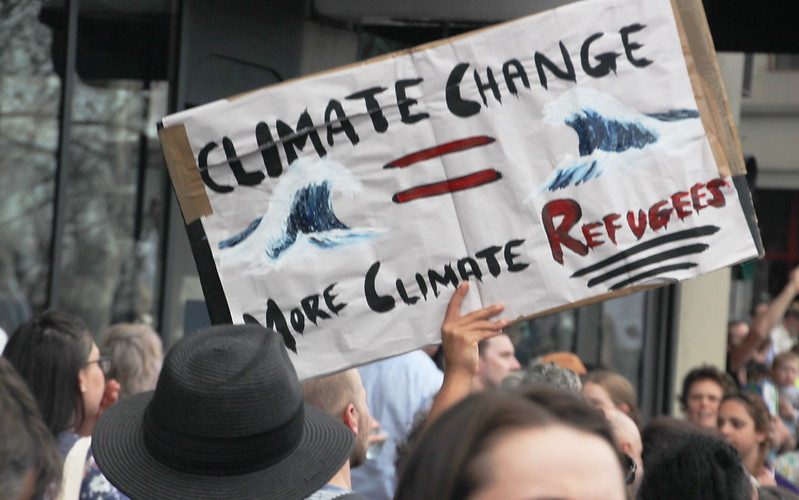Fadhel Kaboub
Most of my recent work has been on the subject of Modern Monetary Theory (MMT) and its implications for transformative climate policies in the Global North as well as the Global South. However, after reading Peo Hansen’s new book, I will also be writing about another important MMT: A Modern Migration Theory: An Alternative Economic Approach to Failed EU Policy (2021). Hansen makes a powerful case for more generous immigration policies in the EU not only because it is the right thing to do morally, but also because of the vast social, cultural, and economic benefits that immigrants bring to Europe. Building on the work of MMT economists, Hansen dismantles the economic foundations of the anti-immigration arguments about refugees adding an unsustainable financial burden on the Swedish economy, and argues that refugees have in fact contributed to an economic boom post-2015.
Refugees brought Prosperity and MMT Insights to Sweden
Despite the fact that the Swedish government was fiscally conservative, it made an exception to the krona för krona fiscal rule between 2015-2017 to welcome 163,000 refugees. According to Hansen, government spending increased by 3.6% in 2016, a rate not seen since the 1970s. “The economy grew and tax revenue surged so much that successive surpluses were created, which is something that may happen, albeit not necessarily. But, as MMT explains, this is not important; what is important is not the fiscal balance at the end of the year but the overall balance and real health of the economy and society” (Hansen 2021, 153).
What we learn from MMT and from Hansen’s book is that governments with high degrees of monetary sovereignty like Sweden have a much higher fiscal spending capacity than what mainstream economists claim. In fact, MMT argues that unlike households, firms and local municipalities (users of the national currency), the sovereign issuer of the national currency is not constrained by tax revenues and borrowing capacity. The government’s spending capacity is constrained by the risk of inflation, which may materialize when the economy runs out of productive capacity (skilled labor, technology, capital equipment, raw materials) and when aggressive price-setting behavior is allowed to dominate certain sectors of the economy.
Sweden can actually expand that additional fiscal spending capacity even more via strategic investments to increase its productive capacity (including more immigrants)
What Sweden did in 2015-2017 was essentially tap into that additional spending capacity that was considered forbidden. I would argue that Sweden can actually expand that additional fiscal spending capacity even more via strategic investments to increase its productive capacity (including more immigrants) and appropriate taxation and regulation policies to prevent high concentration of market power (and oligarchical political influence). In other words, the so-called refugee crisis was in fact an enlightening opportunity for Sweden and other countries in the Global North to recognize the tremendous opportunities available to us to address serious socioeconomic and ecological problems worldwide.
However, I must hasten to say that the Global South countries have a very limited degree of monetary sovereignty because they typically have a large external debt burden (debt denominated in foreign currencies). The larger the external debt, the more desperately a county tries to fix its exchange rate to global currencies like the US dollar or the euro. The roots of this problem are typically related to the lack of food sovereignty, energy sovereignty, and low value-added content exports. I have often described this as a trap, and I have also argued that the standard policy solutions offered to the Global South have in fact created a deeper quagmire that exacerbates colonial and neocolonial structures.
The Global North’s Climate Debt
Let us consider the following observations with regard to the Global South:
- It has limited technological capabilities, weak productive capacity, and no fiscal policy space.
- It has a weaker capacity to deal with corruption, regulate abusive market power, and protect democratic institutions.
- It has an unsustainable external debt.
- It suffers from brain drain.
- It has suffered substantial ecological damage due to extractive industries and global warming.
- It is on the frontlines of climate change.
- It has very limited capacity to build resilient infrastructure to mitigate the effects of climate change.
- It is a net-creditor to the Global North, sending $2 trillion annually to the richest countries on earth.
- It is home to millions of potential climate refugees who will relocate to the Global North.
- It is not responsible for most CO2 emissions since the industrial revolution.
The Global North owes a Climate Debt to the Global South, and the time to settle that debt has been long overdue.
The Global North, however, does not face any of the above-mentioned constraints, and has the technological, logistical, and financial capabilities to address climate change and the subsequent climate refugee exodus from the Global South. The Global North owes a Climate Debt to the Global South, and the time to settle that debt has been long overdue. According to the World Bank, if no climate action is taken, it is estimated that more than 140 million people will be displaced by climate change in the Global South.
Some of the Syrian refugees that arrived in Europe were actually climate refugees. Syria experienced its most severe drought (2006-2011), which affected 3 million people. Long before the conflict started in 2011, the drought forced 1.5 million people to move from rural areas, thus putting substantial pressure on housing, schools, and basic infrastructure in larger cities. During the drought, 85% of the cattle was lost. Agricultural yields dropped by 32% in irrigated areas, and by 80% in rain-fed areas. Poverty and unemployment increased, thus adding more social and political instability. Syria became a net wheat importer during a period when global food prices were skyrocketing. Inflation spiked and pushed 1 million Syrians into food insecurity.
Similar climate-induced migration and conflicts are already happening around the world. Climate change is going to exacerbate water stress and food insecurity, which is likely to increase the likelihood of social unrest, political instability, and armed conflicts. Climate stress is going to be the major push factor in the upcoming climate refugee crisis in the second half of the 21st century.
Climate Reparations; not Aid or Charity
The Green Climate Fund, which was established by the UNFCCC in 2010 was supposed to raise $100 billion by 2020 to help developing countries reduce emissions and mitigate climate risks. Today, the fund only has $8.4 billion, which reflects the level of political commitment in the Global North. Recall that the Global North nets $2 trillion annually from the Global South. This is adding insult to injury. That is why many people in the Global South are calling for climate reparations rather than aid or charity.
The process of reparations starts with telling the truth about the harm that has been inflicted on communities all over the world (including in the Global North).
The process of reparations starts with telling the truth about the harm that has been inflicted on communities all over the world (including in the Global North). This can be done via a global network of Truth and Reconciliation Commissions that will document and hear the grievances of the public. It’s a restorative justice system that sets in motion a global solidarity and healing process. The second step in the reparations process involves offering public apologies to injured communities.
The third and most important step in the process of repairing the damage involves both monetary compensation as well as in-kind reparations starting with substantial reductions in CO2 emissions in the Global North, relocation of displaced people from the Global South, transfer of technology, exemption from intellectual property rights for climate mitigation technologies, delivery of tools, equipment, technical training, and R&D collaborations in the Global South.
Is the Global North prepared to welcome potentially more than 140 million people displaced by climate change? No.
Can the Global North take action now to mitigate the climate risks, help build resilience in the Global South, and prepare the necessary infrastructure in the Global North? Absolutely, yes.
Does the Global North have any incentive to pay climate reparations to the Global South? Yes, for several reasons. First, we want a liveable plan for humanity. Second, we have the resources to achieve it. Third, we have the opportunity to produce a sustainable and prosperous future for all. And fourth, the financial costs of climate inaction are enormous, especially in the Global North.
The Good News: The Carbon Bubble is Real and Wall Street is Panicking
Wall Street is finally (quietly) panicking about climate-induced financial risks that are currently on their books; a massive carbon bubble. Banks, hedge funds, pension funds, insurance companies, mortgage companies, family funds, and endowments have trillions of dollars worth of stranded assets currently on their balance sheets. Trillions of dollars worth of at-risk coastal properties (homes, hotels, resorts, casinos), oil and gas infrastructure that will be made obsolete thanks to more competitive and efficient renewables, unburnable “proven” oil reserves that are priced-in today’s market value, as well as other assets that will lose value when the carbon bubble bursts with the impact of climate change. Most of these stranded assets are held in the Global North, and at the end of the day, it is like a game of musical chairs; when the music stops, a whole lot of people will be left holding a bunch of worthless assets.
Moody’s Analytics estimates economic losses to reach $100 trillion by the year 2100 if global temperatures increase by 2°C degrees (and $77 trillion if we stay below 1.5°C). BlackRock, the largest investment house in the world, is also taking this carbon bubble very seriously. The Federal Reserve Bank now has a Financial Stability Climate Committee, and a Supervision Climate Committee. The European Central Bank is establishing a Climate Change Center with a director reporting directly to the president. Both the Fed and the ECB joined the Network for Greening the Financial System (NGFS) this year. The Securities and Exchange Commission and the Commodity Futures Trading Commission are also bracing for the carbon bubble. The Federal Housing Finance Authority is knee deep in actual financial risks on the books right now. Uninsurable properties due to flood, fire, or hurricane risks are stranded assets that cannot be sold or mortgaged.
… the financial industry in the Global North will be divesting from the carbon economy and will be applying its leverage to accelerate the energy transition.
In other words, the financial industry in the Global North will be divesting from the carbon economy and will be applying its leverage to accelerate the energy transition. Wall Street panicking about climate change means the politicians they bankroll are finally going to take climate change more seriously. However, don’t expect Wall Street to advocate for climate reparations or resettlement of climate refugees anytime soon. The climate justice movement must formulate its own vision, educate, empower, mobilize and organize for genuine global solidarity to prepare for the inevitable climate refugee crisis. Peo Hansen’s book, A Modern Migration Theory: An Alternative Economic Approach to Failed EU Policy (2021), and MMT provide the analytical framework for a coherent and transformative climate justice movement. The People’s Agreement of Cochabamba (2010) provides a solid foundation for climate reparations. Now the real struggle begins.

Fadhel Kaboub is an associate professor of economics at Denison University, and the president of the Global Institute for Sustainable Prosperity. He has held research affiliations with the Levy Economics Institute, and the John F. Kennedy School of Government at Harvard University. He is an expert on Modern Monetary Theory, the Green New Deal, and the Job Guarantee. His work focuses on public policies to enhance monetary and economic sovereignty in the Global South, build resilience, and promote equitable and sustainable prosperity. You can follow him on Twitter @FadhelKaboub and @GISP_Tweets
Image Header Credit: John Englart
TO CITE THIS ARTICLE:
Kaboub, Fadhel 2021. ‘Preparing for a Climate Refugee Tsunami: The Case for Climate Reparations’ Discover Society: New Series 1 (1) https://doi.org/10.51428/dsoc.2021.01.0007




